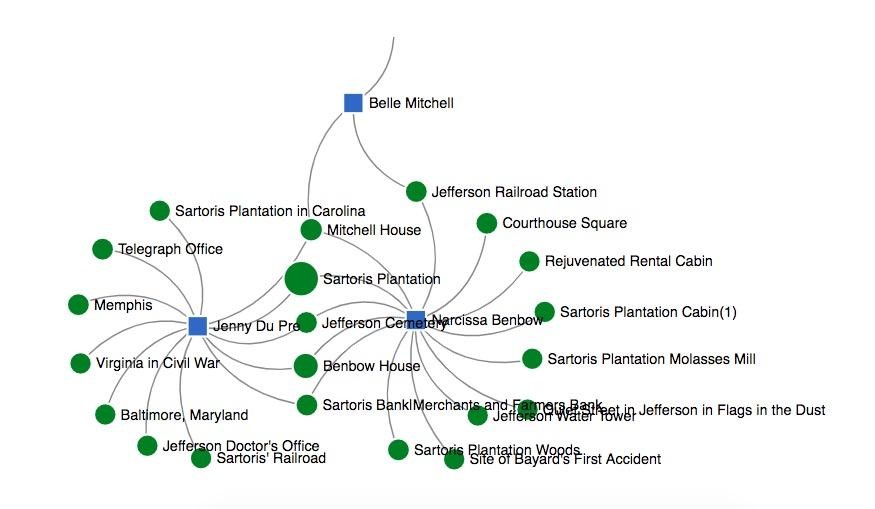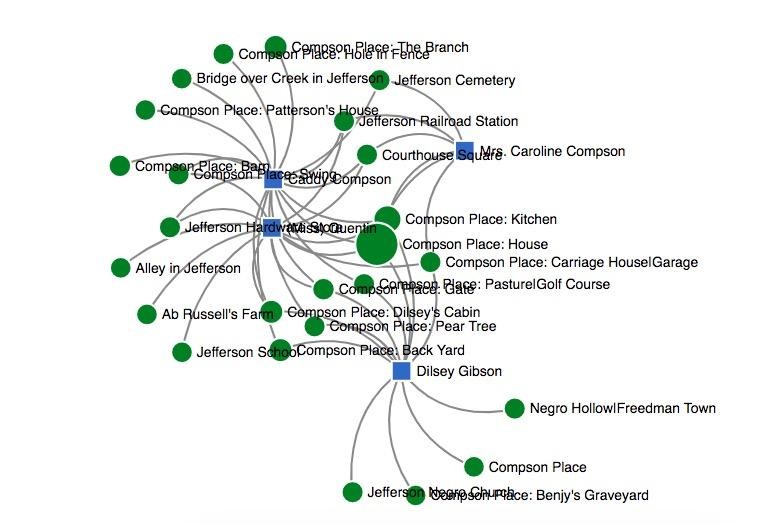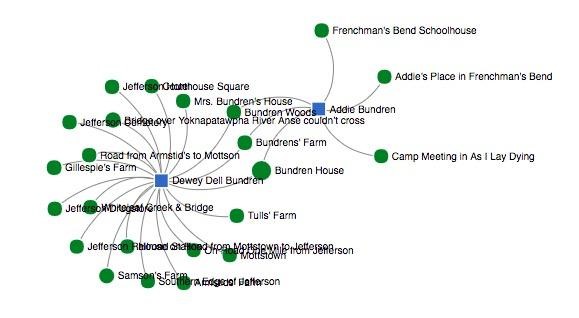Briggs Essay
| CLOSE WINDOW |

|
University of Virginia |
|
Topic of Investigation: Throughout the class so far, we’ve been introduced to several female characters. When discussing these women, we often gravitate around topics of agency and sexuality; however, we have not done much investigation on the settings in which these women exist throughout the narrative. So, I have started my Digital Yoknapatawpha assignment generally looking at the locations in which major female characters are present in the novels we have already read this semester. Where Women Are: Below are the character location maps for each novel in the order of Flags in the Dust, Sound and the Fury, As I Lay Dying, and Light In August.     When I made a search using the Character-Location graphs, I requested the data to be filtered down to only show me major female characters and the locations they are actually present at within each of the four major novels we have read thus far. What I found was predictable. Women in Faulkner's novels overwhelmingly reside within the domestic space of their properties or the properties they work on. They also seem mostly confined within their respective towns. The exceptions to these locations initially intrigued me. I thought perhaps there'd be unique reasons why certain female characters appeared in specific locations that contributed to their overall characterization. Maybe Quentin Compson's appearance in alleyways or Caddy Compson's appearance on a bridge over a creek indicates their alleged promiscuity in secret locations out of the home. Yet, that wasn't the case. I thought perhaps Jenny DuPre's appearances in Memphis and Baltimore were solo journeys that called attention to the greater amount of agency and independence that came with her being that Sartoris' matriarch, but then recalled the trips were either of her past or in the company of a man. This pattern of me thinking "Oh, maybe!" and then ". . . nevermind" was repeated many more times when considering locations outside of the identified norm. Until, I did notice something. Women of the Sartoris, Benbow, Mitchell, and Compson families all predominantly appeared in domestic spaces titled with their last name. For example, "Compson Place: Kitchen" or "Sartoris House." And even while Narcissa Benbow is predominantly located in Sartoris locations instead of Benbow ones, it is because she is being set up to marry young Bayard Sartoris. What these women have in common is that they are a part of or associated with upper class families. These upper class families all reside on large plantations with mansions. In other words, they have all the space they need to exist on their own properties.
In contrast, women of lower to middle classes do not appear in nearly as many locations owned by their families. Dewey Dell Bundren does appear in locations such as the "Bundren Farm"; however, she also appears at "Tull's farm," "Samson's farm” and “Gillespie's farm." While this is mostly due to the Bundren family's voyage to Jefferson, it also represents the hospitality that existed within lower income, rural communities as the Bundren's stop at these other farms on their way to bury Addie. Furthermore, it should be noted that the reasons why the Bundren's journey to Jefferson is so long are that they, one, don't live as close by as the wealthier families who can afford to, and two, they do not have the money for a car or fleet of horses to quickly transport them. So, stopping on their multi-day journey is inevitable due to class barriers. Even more displaced is the character of Lena Grove. Lena, as she exists in Light In August's present tense, does not have a family at all. Thus, on her character location map, aside from her briefly mentioned childhood home, there is no location with her name attached to it. Unlike a Sartoris or Compson, Lena does not have an aristocratic name which entitles her to vast plantations or special accommodations from strangers who recognize her family name. Rather, she primarily is found on the road, in an old slave cabin, or in a men's lodging house. Conclusion: In my process using Digital Yoknapatawpha to find out the location Faulkner places his female characters, I would say that I was both unsuccessful and successful. I was unsuccessful in that I had hoped to find distinctions in the location of women that contributed to their distinct characterizations; however, I did not seem to find any relevant distinctions. This is primarily due to the fact that Faulkner’s novels are already focused so much on Jefferson and family properties. So, regardless of a character’s specific qualities, they’ll likely be located at home or in town. Although, due to the emphasis Faulkner does put on family locations, I was able to make a distinction between where women of different socioeconomic classes appeared. This distinction heavily related to Faulkner’s writing of the old aristocratic south in which wealthy families possessed more property close to centers of wealth, such as the Jefferson’s town square, whereas lower class families lacked less property which was further from urban centers. The Character-Location graphs were especially helpful, because they created a visual graph that outlined all of the locations and named the locations specifically by the name of the owner/s of a location in question, if relevant. Thus, it saved a lot of time where the alternative would have been to go back through the novels to list out the locations myself. Overall, the Character-Location graphs were very useful, and interesting to play around with. Citing this source: |
